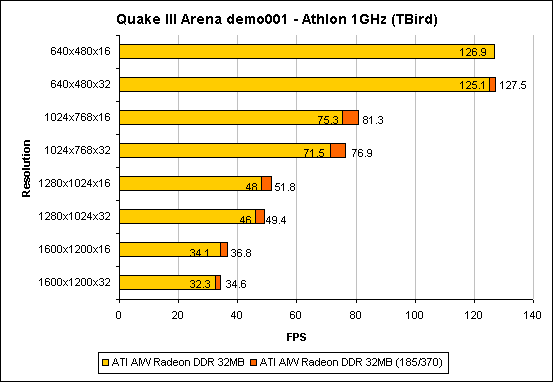ATI All-in-Wonder Radeon 32MB DDR
by Matthew Witheiler on August 21, 2000 3:00 AM EST- Posted in
- GPUs
Overclocked Performance
When we first sat down to overclock our All-in-Wonder Radeon from its standard 166/166 MHz speed, we were a bit surprised with the results. Although we could push the memory clock no higher than 185 MHz, understandable considering the 166 MHz rated speed of the memory, we were quite shocked with the apparent core speed that PowerStrip would let us push the core to: an astounding 246 MHz, the limit. A bit fishy, we thought, but perhaps we got an exceptional core. It was not until we had a conversation with Chris over at Sharky Extreme did we realize what was going on.
It seems that our All-in-Wonder Radeon card has the core and memory speeds locked together, a fact that PowerStrip can not know or fix. Although the program was reporting a core speed of 246 MHz, the core and the memory were both running at the maximum memory speed of 185 MHz. Surprising? You bet, especially considering the fact that our 64MB Radeon did not have this same problem.
There are three explanations to answer why this was happening. First, ATI could have altered the BIOS of only our 64MB Radeon test cards, allowing these test samples to overclock the core and memory clocks independently while the shipping versions did not possess this capability. Secondly, ATI could have revised the BIOS on all Radeon cards and locked the memory and core clocks together, meaning that some early 64MB Radeon cards will be able to overclock the core and the memory to different speeds. Finally, this issue could reside only in our early All-in-Wonder cards or in each All-in-Wonder card. We will investigate the matter further and be sure to report back to you with any information we find.
With that said, we could get our All-in-Wonder Radeon to reach a maximum overclocked speed of 185/185 MHz (185/370 MHz effective). Let's take a look at how the overclocked card performs in comparison to the stock clocked All-in-Wonder Radeon.

As the above graph shows, the largest performance increase comes at 1024x768x32. With a framerate of 76.9 FPS, the All-in-Wonder Radeon lags only 2.7% behind the 64MB Radeon, showing that the largest performance difference between the cards is a result of the different clock speeds. Overclocking the All-in-Wonder Radeon at 1024x768x32 provided in a 7.6% performance increase, resulting in 5.4 additional FPS.










0 Comments
View All Comments